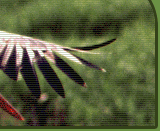| Management plan for Cena Mire Nature Reserve The project management plan expert and other expert studies give new information about the site, nature values and the species of EU importance that occur there. Plants: The raised bog habitats of Cena Mire harbour both the plant species of western distribution in Latvia (Trichophorum cespitosum), as well as of eastern distribution (Chamaedaphne calyculata). The vascular plant flora has the typical species composition, but especially rich is bryophyte flora, especially in Sphagnum species. In total 34 bryophyte species are known there, from which 11 are Sphagnum species. The rarest bryophytes include Sphagnum pulchrum and Splachnum ampullaceum. Also in Cena Mire one locality of Betula nana (protected species in Latvia) is known it is a species that in Latvia reaches the southern border of distribution. In Cena Mire 4 for especially protected plant species of Latvia occur as well. Fungi: In Cena Mire about 60 species of agaricoid fungi are known. One of the rarest is Suillus flavidus that is a protected fungi species in Latvia and a rare one in Europe. Birds: In total 26 species of Bird Directive and protected in Latvia are known in the site. Mostly bird species concentrate near the large raised bog pools and near Skaists Lake. The breeding cranes can reach 20-25 pairs, but not breeding can be hundreds. Cena Mire is an important overnight place for Anser albifrons and A. fabalis during winter migration time about 1000-5000 specimens were counted. In 2-3 areas also Tetrao tetrix has been observed (10-15 specimens). About 5-15 pairs of Pluvialis apricaria were observed. Quite often also Tringa glareola and Lanius collurio were noticed. Invertebrates: In total 6 rare and especially protected species were found, from them 1 from Habitats Directive Annex II - Leucorhinia pectoralis. The rarest species in Latvia Anax imperator was found in the north-west part of Cena Mire near the raised bog pools. Mammals: In total 12 species were found. Cena Mire is regularly visited by 1-3 specimens of Canis lupus, often Lutra lutra and Castor fiber is observed (Habitats Directive Annex II and IV species). Castor fiber lives on mire margins in the drainage ditches in such a way paludifying the nearby spruce forest plantations. Also the traces about the Lynx lynx in the territory were observed. Habitats: In total 5 habitats of Habitats Directive Annex I are known in Cena Mire; from them 2 are priority habitats (7110*, 91D0*). Raised bog covers about 84 % from the total area. In the vicinity of drainage ditches the raised bog habitats have become degraded (7120) or influenced by drainage. Valuable is the transition mire vegetation are in the middle of the raised bog (7140). On the mire margins there is bog woodland (91D0*) and Skaists Lake is a dystrophic lake (3160). Factors that negatively influence Cena Mire The change of the hydrology of Cena Mire due to drainage that was started from 1933. Peat extraction in the areas bordering with Cena Mire Nature Reserve. Agricultural lands and their management in the close vicinity of Cena Mire. Recreation (trampling, waste, fire possibility etc.). Management actions are subordinated to the short-term aims of the protection of the territory. In total 6 there are the short-term aims. To achieve them 32 management actions are planned from which the main include: - Maintenance of raised bogs without any disturbance to allow the natural processes to proceed in the area;
- Restoration of the degraded raised bog habitats) and those influenced by drainage. It includes hydrological studies and elaboration of technical designs for building of dams on the drainage, control of the functioning of the dams;
- Securing favourable conditions for the breeding and migrating bird species (establishment of seasonal protection reserve and marking it in Nature with information signs, bird shooting prohibition);
- Building of a nature trail (1,6km) and a watching tower (6 m high), according to the elaborated technical designs, geological and topographic studies along the route of the trail;
- Establishment of information boards and signs;
- Publishing of informative materials about Cena Mire Nature values and management actions;
- Producing of a film;
- Monitoring the effects of management actions;
- Bird monitoring.
Cultural and historical values: traces of the wooden road from the I World War. Zonation of the territory: Seasonal zonation in the area of 130 ha (from 01.04.-01.11.) Increase of the area of the site has been suggested as in certain places the border crosses valuable raised bog habitats that are not included in the protected area protected Nature, approximately up to the area of an Internationally Important Bird Area. | 







